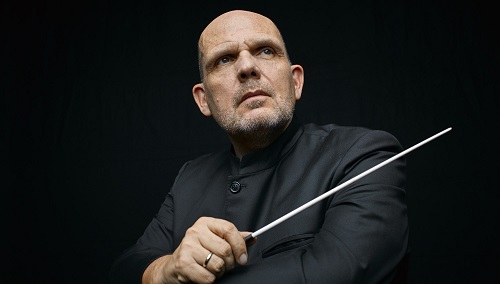 Switzerland Adams, Mahler: Ilya Gringolts (violin), Tonhalle Orchestra Zurich / Jaap van Zweden (conductor). Tonhalle, Zurich, 10.2.2022. (JR)
Switzerland Adams, Mahler: Ilya Gringolts (violin), Tonhalle Orchestra Zurich / Jaap van Zweden (conductor). Tonhalle, Zurich, 10.2.2022. (JR)

Adams – Violin Concerto
Mahler – Symphony No.1 in D major, ‘Titan’
Zurich is starting an informal John Adams Festival and Zurichers are going to hear, over the course of the next few weeks, many of his works, some well-known, others lesser known. More American accents than usual were audible at the Tonhalle, and I know of some fans of this composer who are making the pilgrimage to this city specially. Indeed the composer himself will fly over to conduct some of his pieces soon. It is therefore a good chance to re-assess some of his orchestral oeuvre.
John Adams composed his Violin Concerto in the early Nineties (the result of an unusual three-way commission between the London Symphony Orchestra, the Minnesota Orchestra and New York City Ballet – hence the strong rhythmic element to the work). Adams freely admits that, as a non-string player, he needed guidance for the violin writing. In addition, and above all, he had to find some melodies. In the end, Adams composed a concerto in which the violin plays a string of melody, virtually continuously, with a cadenza in the usual place, at the end of the first movement. Any performance is a tour de force; a brief glance at the score shows an abundance of notes, many – especially in the first movement – high above the stave. Most soloists, including Ilya Gringolts, need to keep a score in sight.
The concerto diverges from the composer’s signature post-minimalist style – an approach Adams has described as ‘massed sonorities riding on great rippling waves of energy’. Instead, this concerto focusses on melody, or what Adams describes as ‘hypermelody’, where, in his words, the violin ‘spins one long phrase after another without stop for nearly the full 35 minutes of the piece’.
The concerto is difficult to pull off: and – it has to be said – the first two movements are probably not enthralling listening for many. The concerto’s first movement is complex, and tightly structured. It includes the use of two synthesisers, which add a modernity to the work (good to see the return, from retirement, of Peter Solomon on Synthesizer 2). After the opening movement’s restless, edgy lyricism, the slow second movement is eerie and dreamlike: the music of Arvo Pärt came to mind, especially when the church bells rang. The final movement is fast and furious with plenty of rhythmic swagger. Gringolts soared in the hair-raising ascents of the first movement, and found a degree of richness in the second movement’s chaconne (with the title of ‘Body through which the dream flows’, after a line by poet Robert Haas). The finale (‘Toccare’) is a perpetuum mobile, where both soloist and orchestra – especially the percussion section (Andreas Berger and Klaus Schwärzler at their best) – are at full pelt. The conservative Zurich audience, I suspect, did not know what had hit them; the Americans in the audience roared their appreciation.
Gringolts hails from Russia and has a penchant for modern works, thus having no difficulty displaying grit and dynamism. He knows the work well, having recorded it with Julien Salemkour and the Copenhagen Philharmonic. One could not fail to be impressed by his power and punch, traits shown in equal measure by Jaap van Zweden on the podium.
And on to Mahler and his First Symphony. I still had the Manfred Honeck performance (review click here) of a few days ago ringing in my ears, so was keen to compare and contrast van Zweden’s interpretation. He is known for his driving energy – but would that be gained at a price? Van Zwenden is currently Music Director at both the Hong Kong Philharmonic and the New York Philharmonic but announced, some months ago, that he will leave both orchestras at the end of the 2023-2024 season. The conductor named the pandemic as a chief contributor to his decision, having effectively been away from the orchestras for two years. This gave him time to be with his family, to compose and explore music away from the classical repertoire (he is apparently a fan of contemporary pop music).
It helped the conductor that he had the forces of the Tonhalle Orchestra and the acoustics of the Tonhalle at his command and assistance. The music had more space to breathe, and in the loud (very loud) sections more chance to thrill and attack. After the first climax, we knew van Zweden’s Mahler 1 would be a different beast to that of Honeck. There was now more electricity, more angst, bite and menace.
The Scherzo benefited from van Zweden’s demonic attack, but where was the joy, the Austrian-Bohemian Gemütlichkeit? This was a thuggish Dutch-American onslaught, impressive at times it must be admitted. There was even a threat of menace in the Funeral March (full marks to Roland Dangel for a faultless introduction).
The orchestra obeyed every direction, the strings worked hard under the leadership of Peter McGuire; another principal to draw praise was Ivo Gass, principal horn.
The opening crash of the final movement was deafening, van Zweden reminding me at times of the conducting style of Sir Georg Solti. It was all very loud, van Zweden (a hard taskmaster in rehearsal I believe) driving the orchestra on with force. He knew what he wanted and was determined to get it. When he jumped into the air on the last note, the audience duly roared.
John Rhodes